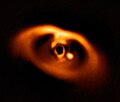| Observation data Epoch J2000 Equinox J2000 | |
|---|---|
| Constellation | Lyra [1] |
| Kepler-13 A | |
| Right ascension | 19h 07m 53.1397s [2] |
| Declination | 46° 52′ 05.922″ [2] |
| Apparent magnitude (V) | 9.95 [3] |
| Kepler-13 B | |
| Right ascension | 19h 07m 53.0281s [4] |
| Declination | 46° 52′ 06.126″ [4] |
| Apparent magnitude (V) | 10.33 [5] |
| Characteristics | |
| Spectral type | A4 |
| Variable type | Planetary transit variable [6] |
| Astrometry | |
| Kepler-13 A | |
| Proper motion (μ) | RA: −4.411(42) mas/yr [2] Dec.: −15.220(50) mas/yr [2] |
| Parallax (π) | 2.0319±0.0344 mas [2] |
| Distance | 1,610 ± 30 ly (492 ± 8 pc) |
| Kepler-13 B | |
| Proper motion (μ) | RA: −4.060(33) mas/yr [4] Dec.: −15.512(40) mas/yr [4] |
| Parallax (π) | 2.0912±0.0263 mas [4] |
| Distance | 1,560 ± 20 ly (478 ± 6 pc) |
| Details [7] | |
| Kepler-13A | |
| Mass | 1.72±0.10 M☉ |
| Radius | 1.71±0.04 R☉ |
| Surface gravity (log g) | 4.2±0.5 cgs |
| Temperature | 7650±250 K |
| Metallicity [Fe/H] | 0.2±0.2 dex |
| Rotational velocity (v sin i) | 78±15 km/s |
| Age | 0.5±0.1 Gyr |
| Kepler-13B | |
| Mass | 1.68±0.10 M☉ |
| Radius | 1.68±0.04 R☉ |
| Surface gravity (log g) | 4.2±0.5 cgs |
| Temperature | 7530±250 K |
| Metallicity [Fe/H] | 0.2±0.2 dex |
| Rotational velocity (v sin i) | 69±13 km/s |
| Age | 0.5±0.1 Gyr |
| Other designations | |
| BD+46 2629, ADS 12085 AB, WDS J19079+4652AB, KOI-13, KIC 9941662, 2MASS J19075308+4652061 [3] | |
| Database references | |
| SIMBAD | data |
Kepler-13 or KOI-13 is a stellar triple star system consisting of Kepler-13A, around which an orbiting hot Jupiter exoplanet was discovered with the Kepler space telescope in 2011, and Kepler-13B a common proper motion companion star which has an additional star orbiting it. [8]

